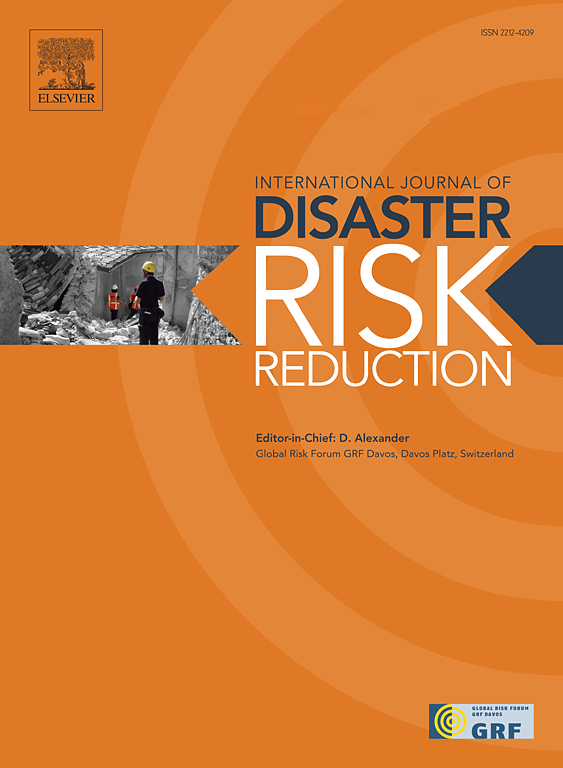Integrating multi-hazard, socio-physical information in a holistic index for decision making on disaster risk reduction
IF 4.2
1区 地球科学
Q1 GEOSCIENCES, MULTIDISCIPLINARY
International journal of disaster risk reduction
Pub Date : 2025-04-16
DOI:10.1016/j.ijdrr.2025.105494
引用次数: 0
Abstract
Effective disaster risk management (DRM) requires a contextual understanding of the underlying risks that should account for: (1) the effects of multiple (natural) hazards on the systems/communities of interest; and (2) social vulnerability factors that influence how different sectors within a given community experience, respond to and cope with these effects. We propose a straightforward multi-hazard risk index for guiding high-level DRM decision making across a large spatial extent, which integrates both of these crucial considerations. The index represents a combination of spatially explicit, probabilistic indicators that collectively capture information on multiple risk dimensions (i.e., multiple hazards, physical and social vulnerability, and population exposure) within a given area. Each of these dimensions can be weighted (i.e., emphasised) to varying degrees in the index calculation, depending on stakeholder DRM priorities, that may vary in relation to different hazards. We apply the index to the entire country of Italy (at the resolution of municipalities) for earthquake and flood risk, using easily accessible open data, which identifies hotspots across the country where disaster risk reduction actions would be particularly beneficial. Sensitivity analyses of the weights assigned to the various risk dimensions reveal how these hotspots can change depending on the relative significance attached to managing different aspects of risk, including different hazards. This finding ultimately underlines the importance of accounting for accurate stakeholder feedback and a multi-layered (and multi-hazard) representation of risk in disaster-related decision making. A prominent advantage of the proposed index is that it is relatively simple and could be easily adopted for practical multi-risk decision support across any other national or transnational context of interest.
综合多种灾害,社会物理信息在一个整体指数的决策,以减少灾害风险
有效的灾害风险管理(DRM)需要对潜在风险有一个上下文理解,这些风险应该考虑:(1)多重(自然)灾害对系统/感兴趣的社区的影响;(2)影响特定社区内不同部门如何体验、应对和应对这些影响的社会脆弱性因素。我们提出了一个直观的多灾害风险指数,用于指导大空间范围内的高水平DRM决策,该指数综合了这两个关键因素。该指数代表了空间明确的概率指标的组合,这些指标共同捕获了特定地区内多个风险维度(即多种危害、物理和社会脆弱性以及人口暴露)的信息。这些维度中的每一个都可以在指数计算中以不同程度加权(即强调),这取决于利益相关者DRM优先级,这可能因不同的危害而有所不同。我们使用易于获取的开放数据,将该指数应用于整个意大利(按市政当局的决议)的地震和洪水风险,这些数据确定了全国各地减少灾害风险行动特别有益的热点地区。对分配给各种风险维度的权重的敏感性分析揭示了这些热点如何根据管理风险的不同方面(包括不同危害)的相对重要性而变化。这一发现最终强调了在灾害相关决策中考虑准确的利益相关者反馈和多层次(和多危害)风险表示的重要性。所建议的指数的一个突出优点是它相对简单,可以很容易地用于在任何其他国家或跨国背景下的实际多风险决策支持。
本文章由计算机程序翻译,如有差异,请以英文原文为准。
求助全文
约1分钟内获得全文
求助全文
来源期刊

International journal of disaster risk reduction
GEOSCIENCES, MULTIDISCIPLINARYMETEOROLOGY-METEOROLOGY & ATMOSPHERIC SCIENCES
CiteScore
8.70
自引率
18.00%
发文量
688
审稿时长
79 days
期刊介绍:
The International Journal of Disaster Risk Reduction (IJDRR) is the journal for researchers, policymakers and practitioners across diverse disciplines: earth sciences and their implications; environmental sciences; engineering; urban studies; geography; and the social sciences. IJDRR publishes fundamental and applied research, critical reviews, policy papers and case studies with a particular focus on multi-disciplinary research that aims to reduce the impact of natural, technological, social and intentional disasters. IJDRR stimulates exchange of ideas and knowledge transfer on disaster research, mitigation, adaptation, prevention and risk reduction at all geographical scales: local, national and international.
Key topics:-
-multifaceted disaster and cascading disasters
-the development of disaster risk reduction strategies and techniques
-discussion and development of effective warning and educational systems for risk management at all levels
-disasters associated with climate change
-vulnerability analysis and vulnerability trends
-emerging risks
-resilience against disasters.
The journal particularly encourages papers that approach risk from a multi-disciplinary perspective.
 求助内容:
求助内容: 应助结果提醒方式:
应助结果提醒方式:


